MBA Project: Organizational Behavior and Personnel Management Analysis
VerifiedAdded on 2022/08/13
|32
|10171
|34
Project
AI Summary
This project analyzes organizational behavior and personnel management, focusing on a case study of Art's Food. The analysis identifies issues such as poor workplace environment, low pay, hostile leadership, and a lack of motivation among employees. The project examines the roles and positions of key staff members, including the director and various team members within the educational department. It explores the causes of these issues and the potential consequences of inaction, such as low motivation, poor performance, and high attrition rates. The project also identifies the company's unmet needs, including motivation, autonomy, improved workplace culture, and fair pay. Furthermore, the project extends to the importance of teamwork and team dynamics, discussing the concepts of groups, teams, and teamwork, and the essentials of leading a work team effectively. The project highlights the importance of empowerment strategies and self-awareness for effective leadership, with a focus on qualities such as efficient perception, self-acceptance, and creativity. The project is based on the guidelines of ENEB Business School and includes details like the student's name and contact information.
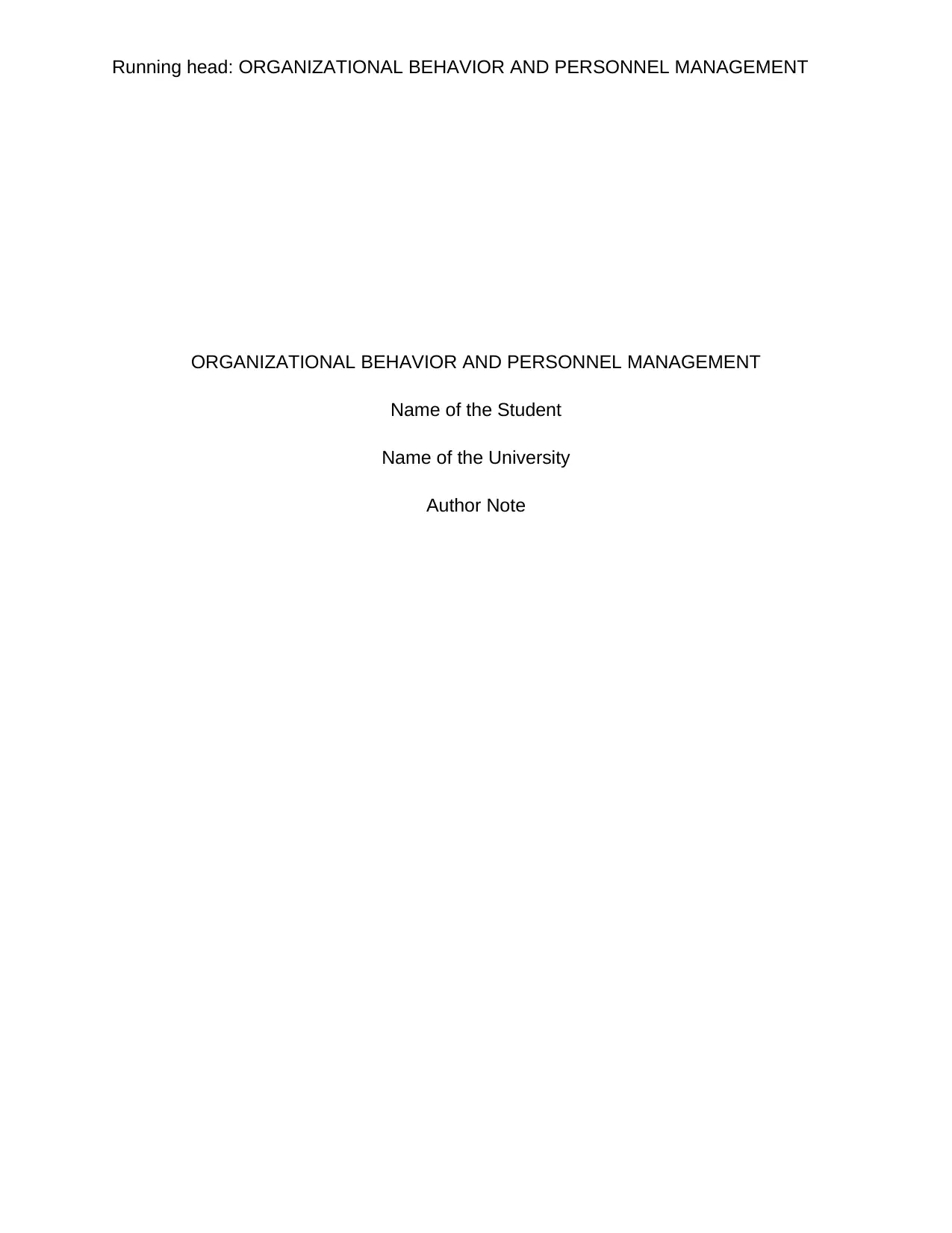
Running head: ORGANIZATIONAL BEHAVIOR AND PERSONNEL MANAGEMENT
ORGANIZATIONAL BEHAVIOR AND PERSONNEL MANAGEMENT
Name of the Student
Name of the University
Author Note
ORGANIZATIONAL BEHAVIOR AND PERSONNEL MANAGEMENT
Name of the Student
Name of the University
Author Note
Paraphrase This Document
Need a fresh take? Get an instant paraphrase of this document with our AI Paraphraser
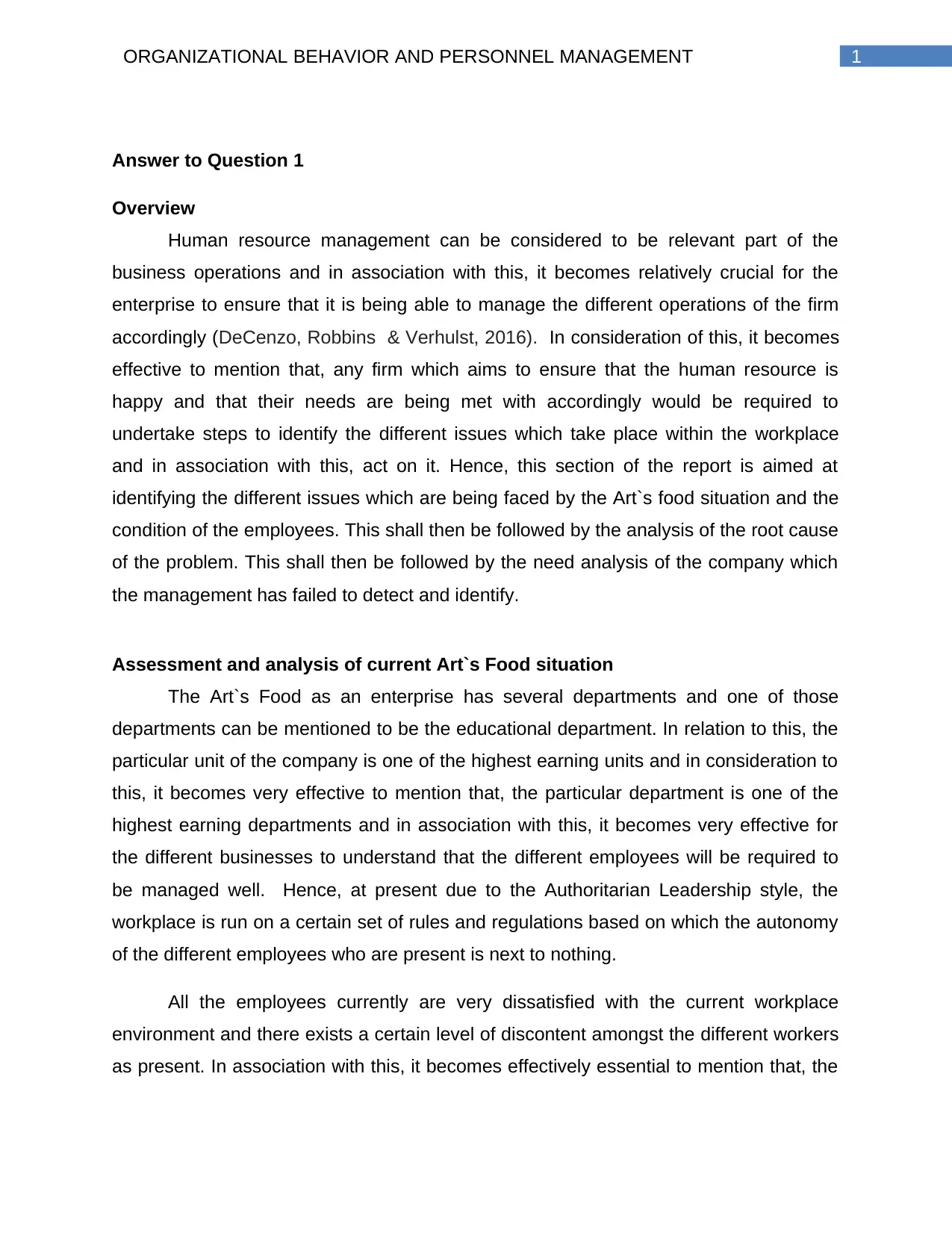
1ORGANIZATIONAL BEHAVIOR AND PERSONNEL MANAGEMENT
Answer to Question 1
Overview
Human resource management can be considered to be relevant part of the
business operations and in association with this, it becomes relatively crucial for the
enterprise to ensure that it is being able to manage the different operations of the firm
accordingly (DeCenzo, Robbins & Verhulst, 2016). In consideration of this, it becomes
effective to mention that, any firm which aims to ensure that the human resource is
happy and that their needs are being met with accordingly would be required to
undertake steps to identify the different issues which take place within the workplace
and in association with this, act on it. Hence, this section of the report is aimed at
identifying the different issues which are being faced by the Art`s food situation and the
condition of the employees. This shall then be followed by the analysis of the root cause
of the problem. This shall then be followed by the need analysis of the company which
the management has failed to detect and identify.
Assessment and analysis of current Art`s Food situation
The Art`s Food as an enterprise has several departments and one of those
departments can be mentioned to be the educational department. In relation to this, the
particular unit of the company is one of the highest earning units and in consideration to
this, it becomes very effective to mention that, the particular department is one of the
highest earning departments and in association with this, it becomes very effective for
the different businesses to understand that the different employees will be required to
be managed well. Hence, at present due to the Authoritarian Leadership style, the
workplace is run on a certain set of rules and regulations based on which the autonomy
of the different employees who are present is next to nothing.
All the employees currently are very dissatisfied with the current workplace
environment and there exists a certain level of discontent amongst the different workers
as present. In association with this, it becomes effectively essential to mention that, the
Answer to Question 1
Overview
Human resource management can be considered to be relevant part of the
business operations and in association with this, it becomes relatively crucial for the
enterprise to ensure that it is being able to manage the different operations of the firm
accordingly (DeCenzo, Robbins & Verhulst, 2016). In consideration of this, it becomes
effective to mention that, any firm which aims to ensure that the human resource is
happy and that their needs are being met with accordingly would be required to
undertake steps to identify the different issues which take place within the workplace
and in association with this, act on it. Hence, this section of the report is aimed at
identifying the different issues which are being faced by the Art`s food situation and the
condition of the employees. This shall then be followed by the analysis of the root cause
of the problem. This shall then be followed by the need analysis of the company which
the management has failed to detect and identify.
Assessment and analysis of current Art`s Food situation
The Art`s Food as an enterprise has several departments and one of those
departments can be mentioned to be the educational department. In relation to this, the
particular unit of the company is one of the highest earning units and in consideration to
this, it becomes very effective to mention that, the particular department is one of the
highest earning departments and in association with this, it becomes very effective for
the different businesses to understand that the different employees will be required to
be managed well. Hence, at present due to the Authoritarian Leadership style, the
workplace is run on a certain set of rules and regulations based on which the autonomy
of the different employees who are present is next to nothing.
All the employees currently are very dissatisfied with the current workplace
environment and there exists a certain level of discontent amongst the different workers
as present. In association with this, it becomes effectively essential to mention that, the
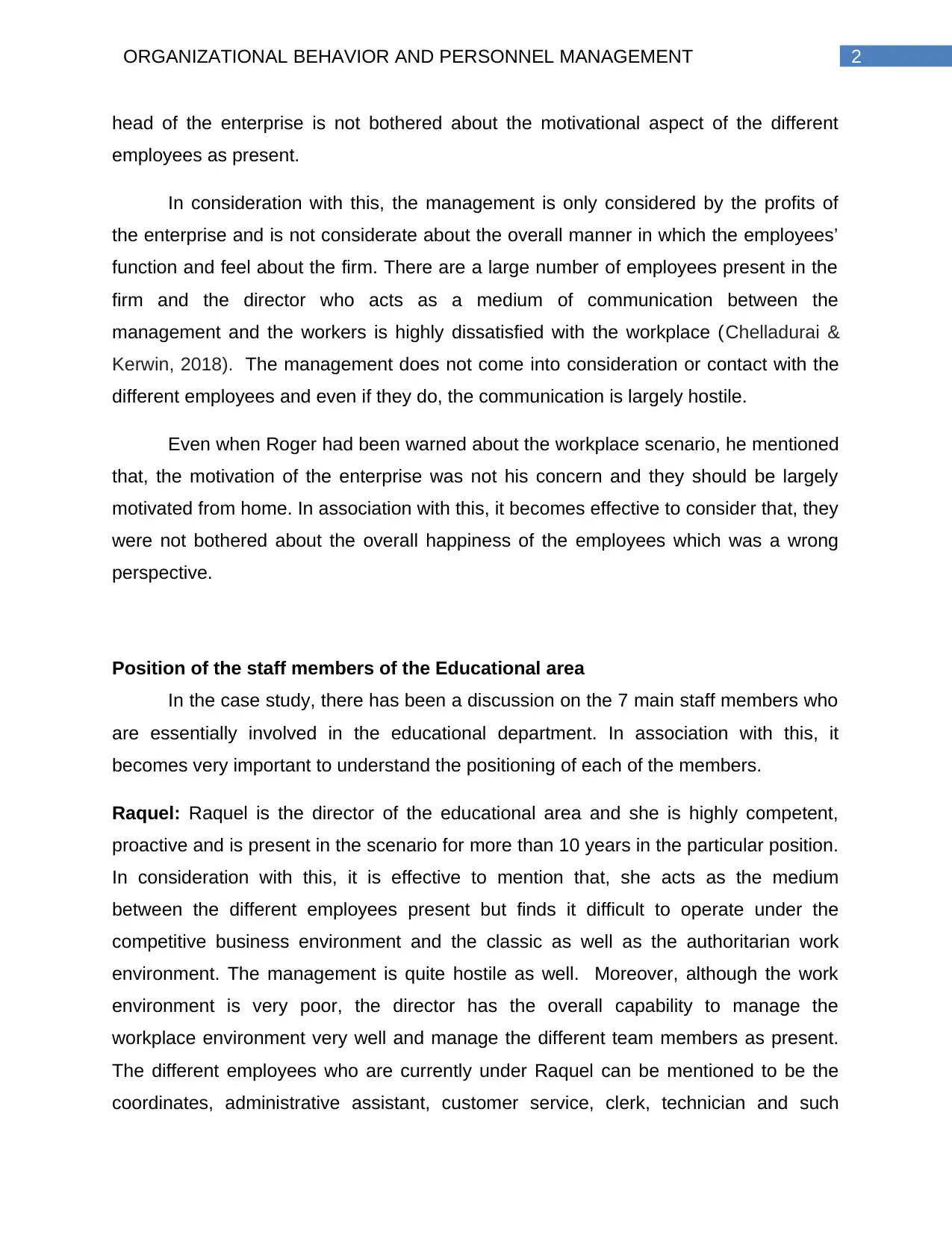
2ORGANIZATIONAL BEHAVIOR AND PERSONNEL MANAGEMENT
head of the enterprise is not bothered about the motivational aspect of the different
employees as present.
In consideration with this, the management is only considered by the profits of
the enterprise and is not considerate about the overall manner in which the employees’
function and feel about the firm. There are a large number of employees present in the
firm and the director who acts as a medium of communication between the
management and the workers is highly dissatisfied with the workplace (Chelladurai &
Kerwin, 2018). The management does not come into consideration or contact with the
different employees and even if they do, the communication is largely hostile.
Even when Roger had been warned about the workplace scenario, he mentioned
that, the motivation of the enterprise was not his concern and they should be largely
motivated from home. In association with this, it becomes effective to consider that, they
were not bothered about the overall happiness of the employees which was a wrong
perspective.
Position of the staff members of the Educational area
In the case study, there has been a discussion on the 7 main staff members who
are essentially involved in the educational department. In association with this, it
becomes very important to understand the positioning of each of the members.
Raquel: Raquel is the director of the educational area and she is highly competent,
proactive and is present in the scenario for more than 10 years in the particular position.
In consideration with this, it is effective to mention that, she acts as the medium
between the different employees present but finds it difficult to operate under the
competitive business environment and the classic as well as the authoritarian work
environment. The management is quite hostile as well. Moreover, although the work
environment is very poor, the director has the overall capability to manage the
workplace environment very well and manage the different team members as present.
The different employees who are currently under Raquel can be mentioned to be the
coordinates, administrative assistant, customer service, clerk, technician and such
head of the enterprise is not bothered about the motivational aspect of the different
employees as present.
In consideration with this, the management is only considered by the profits of
the enterprise and is not considerate about the overall manner in which the employees’
function and feel about the firm. There are a large number of employees present in the
firm and the director who acts as a medium of communication between the
management and the workers is highly dissatisfied with the workplace (Chelladurai &
Kerwin, 2018). The management does not come into consideration or contact with the
different employees and even if they do, the communication is largely hostile.
Even when Roger had been warned about the workplace scenario, he mentioned
that, the motivation of the enterprise was not his concern and they should be largely
motivated from home. In association with this, it becomes effective to consider that, they
were not bothered about the overall happiness of the employees which was a wrong
perspective.
Position of the staff members of the Educational area
In the case study, there has been a discussion on the 7 main staff members who
are essentially involved in the educational department. In association with this, it
becomes very important to understand the positioning of each of the members.
Raquel: Raquel is the director of the educational area and she is highly competent,
proactive and is present in the scenario for more than 10 years in the particular position.
In consideration with this, it is effective to mention that, she acts as the medium
between the different employees present but finds it difficult to operate under the
competitive business environment and the classic as well as the authoritarian work
environment. The management is quite hostile as well. Moreover, although the work
environment is very poor, the director has the overall capability to manage the
workplace environment very well and manage the different team members as present.
The different employees who are currently under Raquel can be mentioned to be the
coordinates, administrative assistant, customer service, clerk, technician and such
⊘ This is a preview!⊘
Do you want full access?
Subscribe today to unlock all pages.

Trusted by 1+ million students worldwide

3ORGANIZATIONAL BEHAVIOR AND PERSONNEL MANAGEMENT
others. They rely on Raquel and manage the stressful environment to a great extent. At
present due to being paid less, Raquel has accepted another offer which has led to
great stress within the company and her team in general.
Joan: Joan can be understood to be another member of the team who is greatly
involved in the firm for the past six years. He is selfish and has a normal association
with the employees present. He is highly concerned about his own positioned and is
focused on understanding how the enterprise generally tends to perform. In association
with this, he is unfazed by the current surroundings.
Enrique: Enrique is a salesman who is in the third year of the company and has a very
good rapport with the different employees as present in the enterprise. The current
situation has caught him unguarded and he is under the belief that the current scenario
is quite unfair and needs to be improved to restore a positive and inductive workplace
environment.
Lorena: Lorena is the assistant of Raquel and is a relevant part of the team. She is
cheerful and carries out her operations adequately well. She is dynamic in nature and
her position in the firm is essentially very crucial. In association with this, she as an
employee in an enterprise feels very unsafe and does not feel that she is being valued
at all which is currently bringing down her motivational level.
Elisabeth: She is one of the seniors most employees involved in the routine actions.
She performs her job very well and has the ability to manage the customers well. She is
one of the most encouraging employees as present in the workplace. In relation to this,
it is critical to note that, she is an important part of the firm and has suffered the impact
of the poor workplace environment.
Julia: Julia has been employed at the workplace for 5 months and deals with the
parents of the children and undertakes other administrative tasks. As she is young and
new to the firm, she wants to ensure that she does not get involved in the various
controversies which tend to take place in the enterprise but clearly realizes that the work
environment is not safe at all and that the work environment is very discouraging in
nature.
others. They rely on Raquel and manage the stressful environment to a great extent. At
present due to being paid less, Raquel has accepted another offer which has led to
great stress within the company and her team in general.
Joan: Joan can be understood to be another member of the team who is greatly
involved in the firm for the past six years. He is selfish and has a normal association
with the employees present. He is highly concerned about his own positioned and is
focused on understanding how the enterprise generally tends to perform. In association
with this, he is unfazed by the current surroundings.
Enrique: Enrique is a salesman who is in the third year of the company and has a very
good rapport with the different employees as present in the enterprise. The current
situation has caught him unguarded and he is under the belief that the current scenario
is quite unfair and needs to be improved to restore a positive and inductive workplace
environment.
Lorena: Lorena is the assistant of Raquel and is a relevant part of the team. She is
cheerful and carries out her operations adequately well. She is dynamic in nature and
her position in the firm is essentially very crucial. In association with this, she as an
employee in an enterprise feels very unsafe and does not feel that she is being valued
at all which is currently bringing down her motivational level.
Elisabeth: She is one of the seniors most employees involved in the routine actions.
She performs her job very well and has the ability to manage the customers well. She is
one of the most encouraging employees as present in the workplace. In relation to this,
it is critical to note that, she is an important part of the firm and has suffered the impact
of the poor workplace environment.
Julia: Julia has been employed at the workplace for 5 months and deals with the
parents of the children and undertakes other administrative tasks. As she is young and
new to the firm, she wants to ensure that she does not get involved in the various
controversies which tend to take place in the enterprise but clearly realizes that the work
environment is not safe at all and that the work environment is very discouraging in
nature.
Paraphrase This Document
Need a fresh take? Get an instant paraphrase of this document with our AI Paraphraser
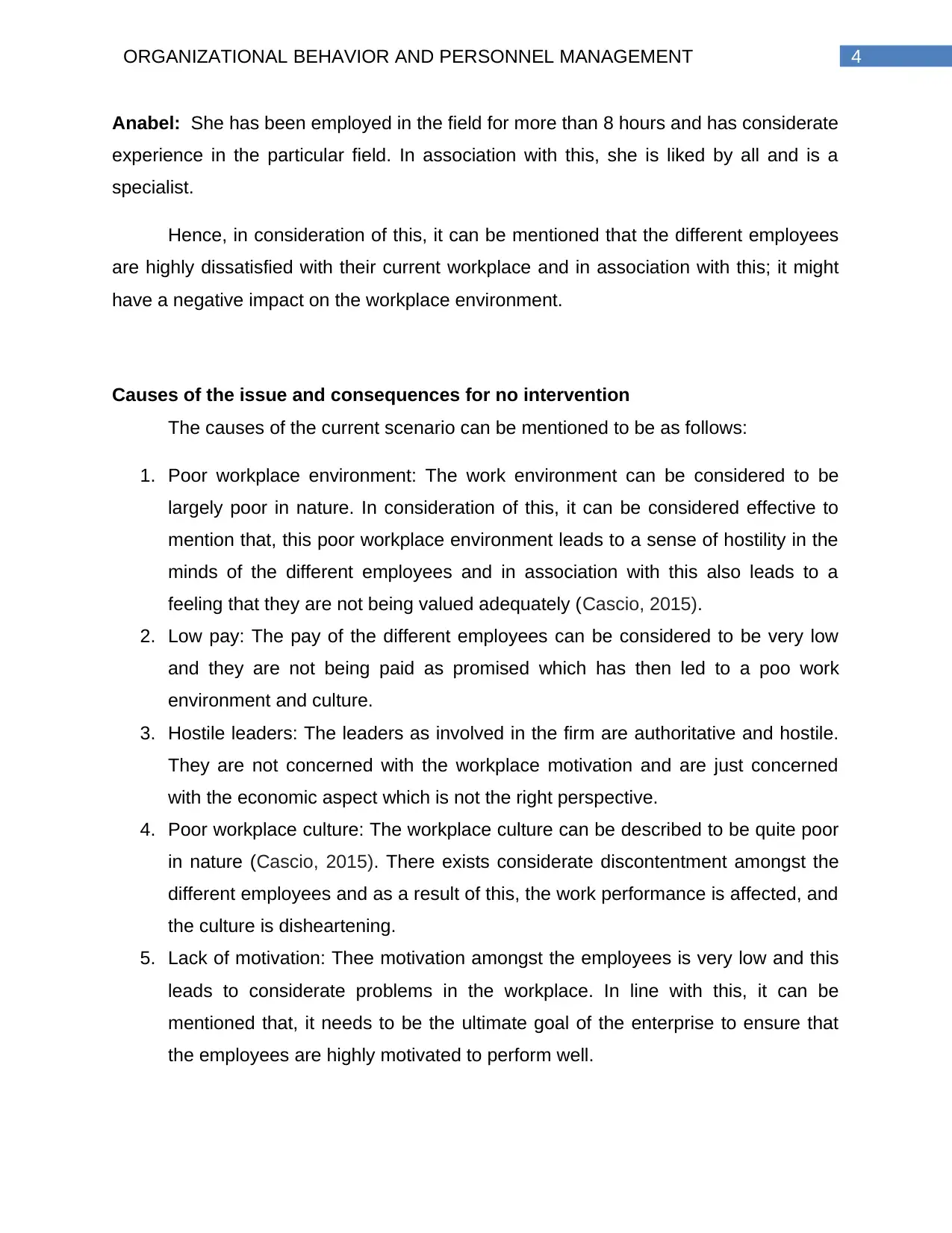
4ORGANIZATIONAL BEHAVIOR AND PERSONNEL MANAGEMENT
Anabel: She has been employed in the field for more than 8 hours and has considerate
experience in the particular field. In association with this, she is liked by all and is a
specialist.
Hence, in consideration of this, it can be mentioned that the different employees
are highly dissatisfied with their current workplace and in association with this; it might
have a negative impact on the workplace environment.
Causes of the issue and consequences for no intervention
The causes of the current scenario can be mentioned to be as follows:
1. Poor workplace environment: The work environment can be considered to be
largely poor in nature. In consideration of this, it can be considered effective to
mention that, this poor workplace environment leads to a sense of hostility in the
minds of the different employees and in association with this also leads to a
feeling that they are not being valued adequately (Cascio, 2015).
2. Low pay: The pay of the different employees can be considered to be very low
and they are not being paid as promised which has then led to a poo work
environment and culture.
3. Hostile leaders: The leaders as involved in the firm are authoritative and hostile.
They are not concerned with the workplace motivation and are just concerned
with the economic aspect which is not the right perspective.
4. Poor workplace culture: The workplace culture can be described to be quite poor
in nature (Cascio, 2015). There exists considerate discontentment amongst the
different employees and as a result of this, the work performance is affected, and
the culture is disheartening.
5. Lack of motivation: Thee motivation amongst the employees is very low and this
leads to considerate problems in the workplace. In line with this, it can be
mentioned that, it needs to be the ultimate goal of the enterprise to ensure that
the employees are highly motivated to perform well.
Anabel: She has been employed in the field for more than 8 hours and has considerate
experience in the particular field. In association with this, she is liked by all and is a
specialist.
Hence, in consideration of this, it can be mentioned that the different employees
are highly dissatisfied with their current workplace and in association with this; it might
have a negative impact on the workplace environment.
Causes of the issue and consequences for no intervention
The causes of the current scenario can be mentioned to be as follows:
1. Poor workplace environment: The work environment can be considered to be
largely poor in nature. In consideration of this, it can be considered effective to
mention that, this poor workplace environment leads to a sense of hostility in the
minds of the different employees and in association with this also leads to a
feeling that they are not being valued adequately (Cascio, 2015).
2. Low pay: The pay of the different employees can be considered to be very low
and they are not being paid as promised which has then led to a poo work
environment and culture.
3. Hostile leaders: The leaders as involved in the firm are authoritative and hostile.
They are not concerned with the workplace motivation and are just concerned
with the economic aspect which is not the right perspective.
4. Poor workplace culture: The workplace culture can be described to be quite poor
in nature (Cascio, 2015). There exists considerate discontentment amongst the
different employees and as a result of this, the work performance is affected, and
the culture is disheartening.
5. Lack of motivation: Thee motivation amongst the employees is very low and this
leads to considerate problems in the workplace. In line with this, it can be
mentioned that, it needs to be the ultimate goal of the enterprise to ensure that
the employees are highly motivated to perform well.
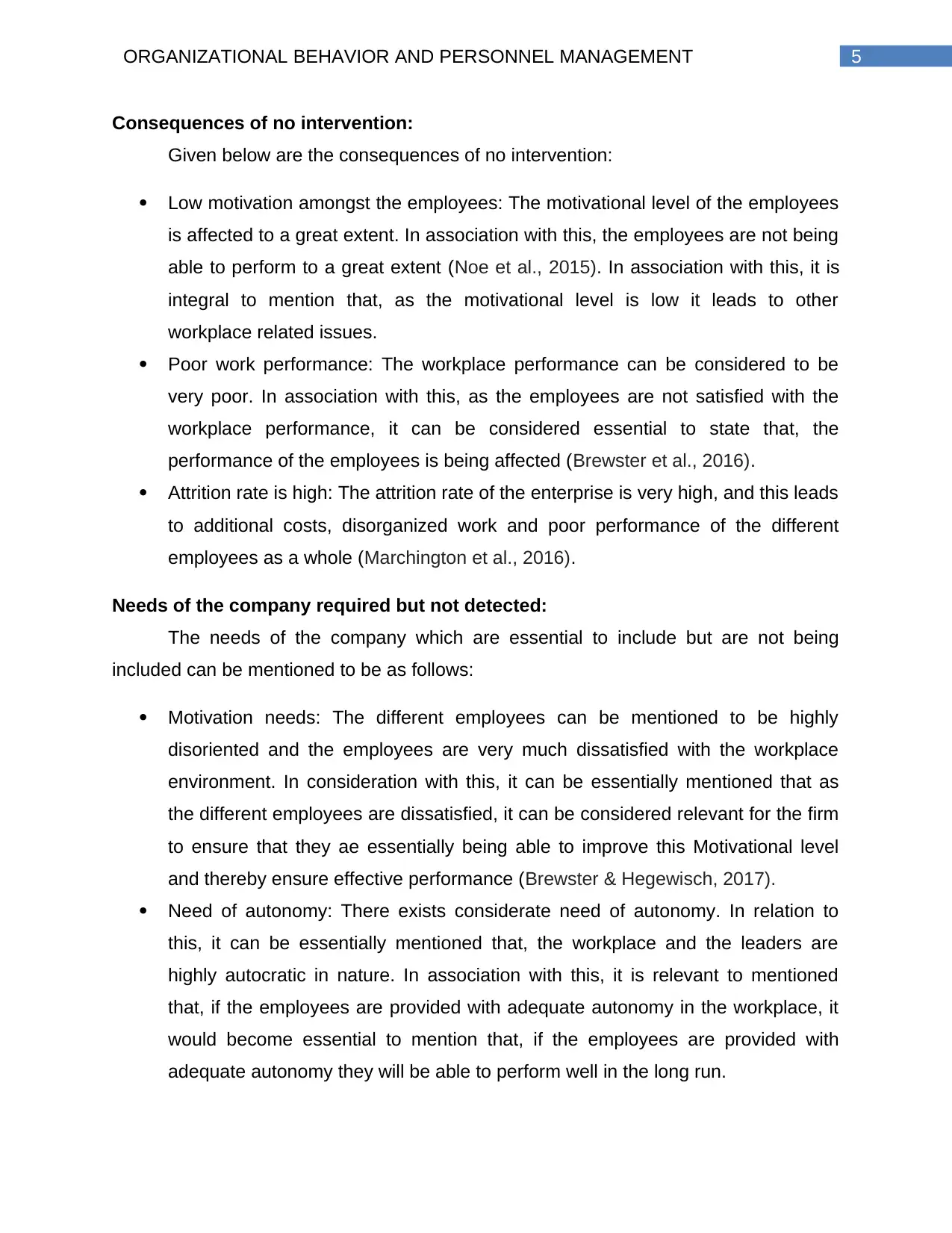
5ORGANIZATIONAL BEHAVIOR AND PERSONNEL MANAGEMENT
Consequences of no intervention:
Given below are the consequences of no intervention:
Low motivation amongst the employees: The motivational level of the employees
is affected to a great extent. In association with this, the employees are not being
able to perform to a great extent (Noe et al., 2015). In association with this, it is
integral to mention that, as the motivational level is low it leads to other
workplace related issues.
Poor work performance: The workplace performance can be considered to be
very poor. In association with this, as the employees are not satisfied with the
workplace performance, it can be considered essential to state that, the
performance of the employees is being affected (Brewster et al., 2016).
Attrition rate is high: The attrition rate of the enterprise is very high, and this leads
to additional costs, disorganized work and poor performance of the different
employees as a whole (Marchington et al., 2016).
Needs of the company required but not detected:
The needs of the company which are essential to include but are not being
included can be mentioned to be as follows:
Motivation needs: The different employees can be mentioned to be highly
disoriented and the employees are very much dissatisfied with the workplace
environment. In consideration with this, it can be essentially mentioned that as
the different employees are dissatisfied, it can be considered relevant for the firm
to ensure that they ae essentially being able to improve this Motivational level
and thereby ensure effective performance (Brewster & Hegewisch, 2017).
Need of autonomy: There exists considerate need of autonomy. In relation to
this, it can be essentially mentioned that, the workplace and the leaders are
highly autocratic in nature. In association with this, it is relevant to mentioned
that, if the employees are provided with adequate autonomy in the workplace, it
would become essential to mention that, if the employees are provided with
adequate autonomy they will be able to perform well in the long run.
Consequences of no intervention:
Given below are the consequences of no intervention:
Low motivation amongst the employees: The motivational level of the employees
is affected to a great extent. In association with this, the employees are not being
able to perform to a great extent (Noe et al., 2015). In association with this, it is
integral to mention that, as the motivational level is low it leads to other
workplace related issues.
Poor work performance: The workplace performance can be considered to be
very poor. In association with this, as the employees are not satisfied with the
workplace performance, it can be considered essential to state that, the
performance of the employees is being affected (Brewster et al., 2016).
Attrition rate is high: The attrition rate of the enterprise is very high, and this leads
to additional costs, disorganized work and poor performance of the different
employees as a whole (Marchington et al., 2016).
Needs of the company required but not detected:
The needs of the company which are essential to include but are not being
included can be mentioned to be as follows:
Motivation needs: The different employees can be mentioned to be highly
disoriented and the employees are very much dissatisfied with the workplace
environment. In consideration with this, it can be essentially mentioned that as
the different employees are dissatisfied, it can be considered relevant for the firm
to ensure that they ae essentially being able to improve this Motivational level
and thereby ensure effective performance (Brewster & Hegewisch, 2017).
Need of autonomy: There exists considerate need of autonomy. In relation to
this, it can be essentially mentioned that, the workplace and the leaders are
highly autocratic in nature. In association with this, it is relevant to mentioned
that, if the employees are provided with adequate autonomy in the workplace, it
would become essential to mention that, if the employees are provided with
adequate autonomy they will be able to perform well in the long run.
⊘ This is a preview!⊘
Do you want full access?
Subscribe today to unlock all pages.

Trusted by 1+ million students worldwide
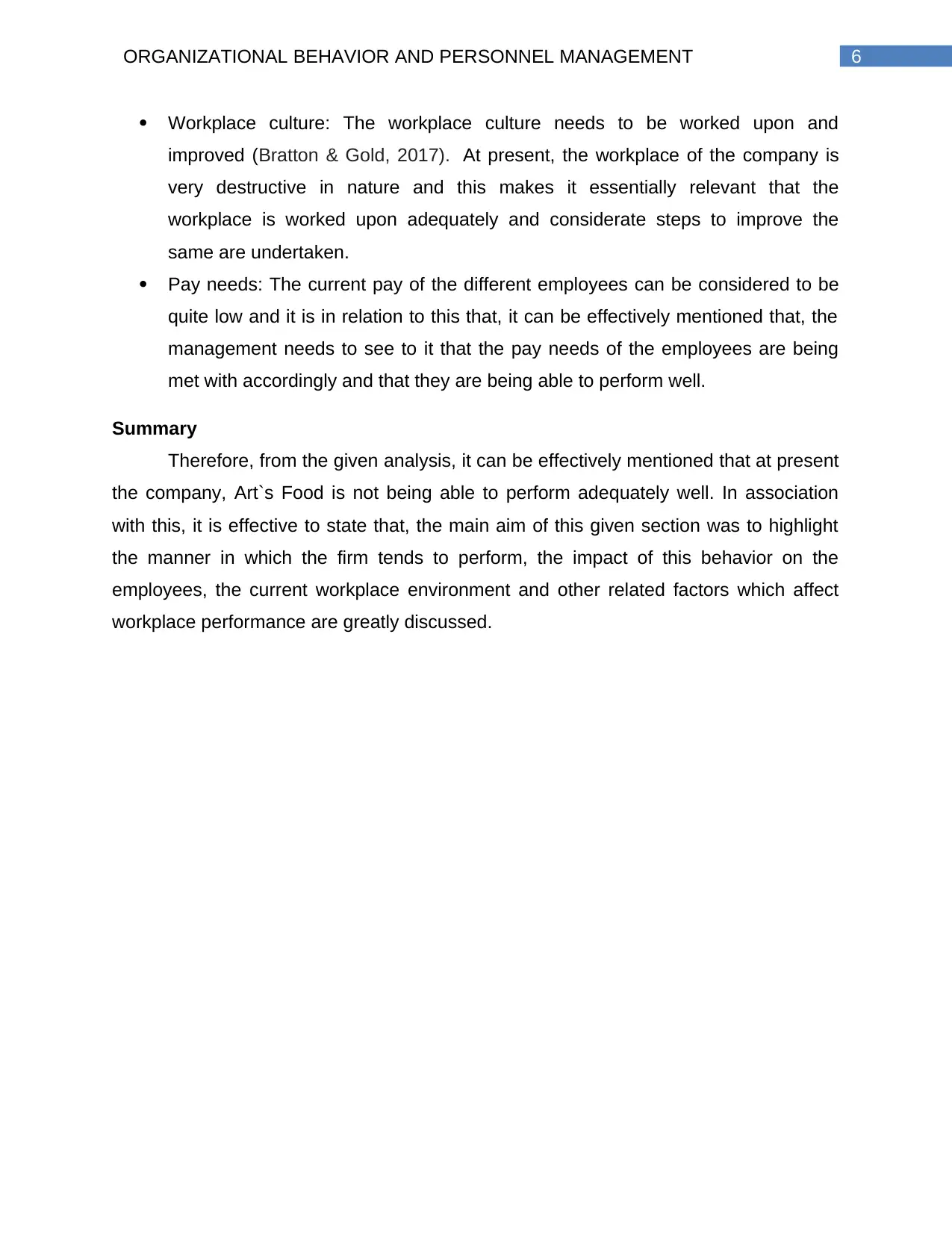
6ORGANIZATIONAL BEHAVIOR AND PERSONNEL MANAGEMENT
Workplace culture: The workplace culture needs to be worked upon and
improved (Bratton & Gold, 2017). At present, the workplace of the company is
very destructive in nature and this makes it essentially relevant that the
workplace is worked upon adequately and considerate steps to improve the
same are undertaken.
Pay needs: The current pay of the different employees can be considered to be
quite low and it is in relation to this that, it can be effectively mentioned that, the
management needs to see to it that the pay needs of the employees are being
met with accordingly and that they are being able to perform well.
Summary
Therefore, from the given analysis, it can be effectively mentioned that at present
the company, Art`s Food is not being able to perform adequately well. In association
with this, it is effective to state that, the main aim of this given section was to highlight
the manner in which the firm tends to perform, the impact of this behavior on the
employees, the current workplace environment and other related factors which affect
workplace performance are greatly discussed.
Workplace culture: The workplace culture needs to be worked upon and
improved (Bratton & Gold, 2017). At present, the workplace of the company is
very destructive in nature and this makes it essentially relevant that the
workplace is worked upon adequately and considerate steps to improve the
same are undertaken.
Pay needs: The current pay of the different employees can be considered to be
quite low and it is in relation to this that, it can be effectively mentioned that, the
management needs to see to it that the pay needs of the employees are being
met with accordingly and that they are being able to perform well.
Summary
Therefore, from the given analysis, it can be effectively mentioned that at present
the company, Art`s Food is not being able to perform adequately well. In association
with this, it is effective to state that, the main aim of this given section was to highlight
the manner in which the firm tends to perform, the impact of this behavior on the
employees, the current workplace environment and other related factors which affect
workplace performance are greatly discussed.
Paraphrase This Document
Need a fresh take? Get an instant paraphrase of this document with our AI Paraphraser
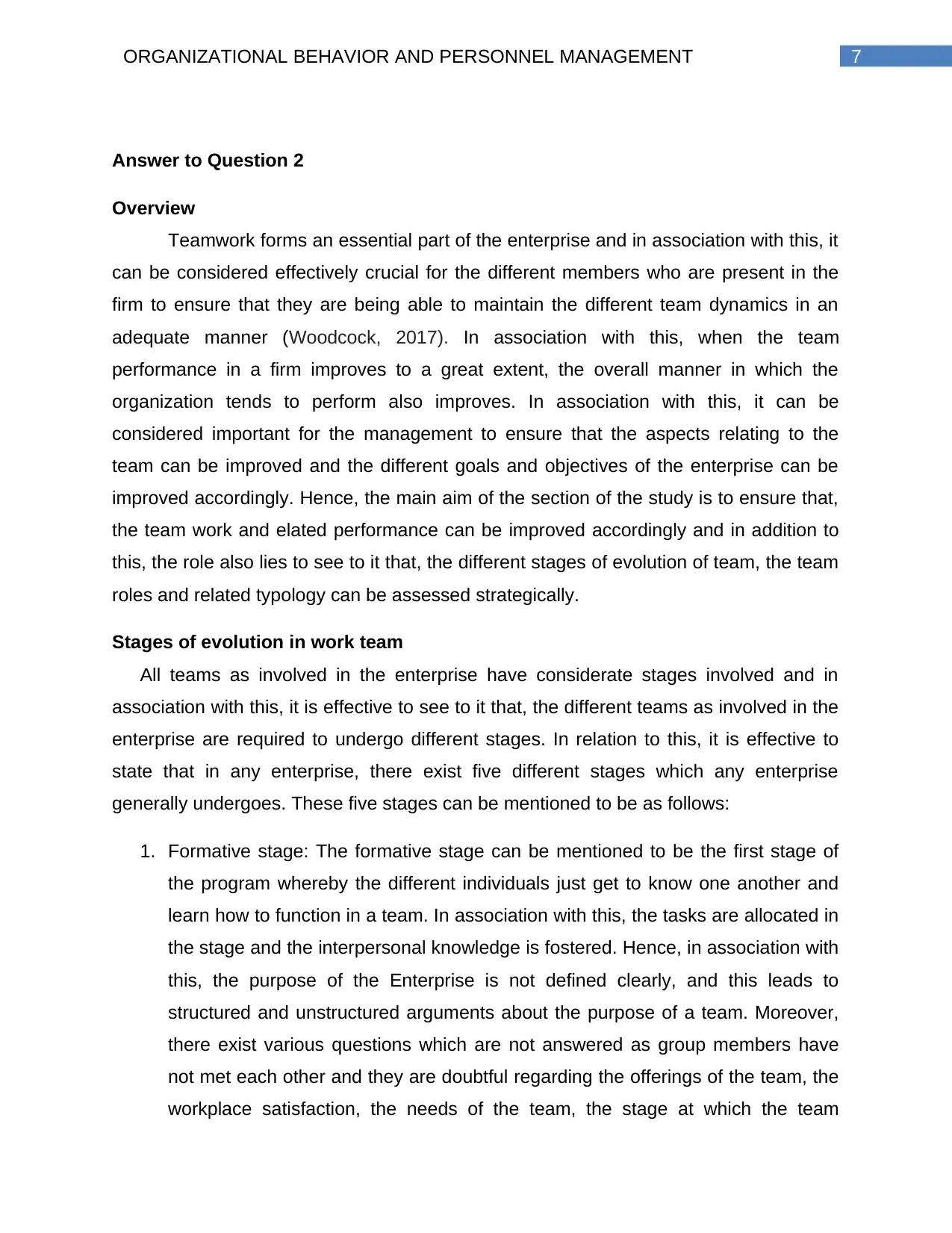
7ORGANIZATIONAL BEHAVIOR AND PERSONNEL MANAGEMENT
Answer to Question 2
Overview
Teamwork forms an essential part of the enterprise and in association with this, it
can be considered effectively crucial for the different members who are present in the
firm to ensure that they are being able to maintain the different team dynamics in an
adequate manner (Woodcock, 2017). In association with this, when the team
performance in a firm improves to a great extent, the overall manner in which the
organization tends to perform also improves. In association with this, it can be
considered important for the management to ensure that the aspects relating to the
team can be improved and the different goals and objectives of the enterprise can be
improved accordingly. Hence, the main aim of the section of the study is to ensure that,
the team work and elated performance can be improved accordingly and in addition to
this, the role also lies to see to it that, the different stages of evolution of team, the team
roles and related typology can be assessed strategically.
Stages of evolution in work team
All teams as involved in the enterprise have considerate stages involved and in
association with this, it is effective to see to it that, the different teams as involved in the
enterprise are required to undergo different stages. In relation to this, it is effective to
state that in any enterprise, there exist five different stages which any enterprise
generally undergoes. These five stages can be mentioned to be as follows:
1. Formative stage: The formative stage can be mentioned to be the first stage of
the program whereby the different individuals just get to know one another and
learn how to function in a team. In association with this, the tasks are allocated in
the stage and the interpersonal knowledge is fostered. Hence, in association with
this, the purpose of the Enterprise is not defined clearly, and this leads to
structured and unstructured arguments about the purpose of a team. Moreover,
there exist various questions which are not answered as group members have
not met each other and they are doubtful regarding the offerings of the team, the
workplace satisfaction, the needs of the team, the stage at which the team
Answer to Question 2
Overview
Teamwork forms an essential part of the enterprise and in association with this, it
can be considered effectively crucial for the different members who are present in the
firm to ensure that they are being able to maintain the different team dynamics in an
adequate manner (Woodcock, 2017). In association with this, when the team
performance in a firm improves to a great extent, the overall manner in which the
organization tends to perform also improves. In association with this, it can be
considered important for the management to ensure that the aspects relating to the
team can be improved and the different goals and objectives of the enterprise can be
improved accordingly. Hence, the main aim of the section of the study is to ensure that,
the team work and elated performance can be improved accordingly and in addition to
this, the role also lies to see to it that, the different stages of evolution of team, the team
roles and related typology can be assessed strategically.
Stages of evolution in work team
All teams as involved in the enterprise have considerate stages involved and in
association with this, it is effective to see to it that, the different teams as involved in the
enterprise are required to undergo different stages. In relation to this, it is effective to
state that in any enterprise, there exist five different stages which any enterprise
generally undergoes. These five stages can be mentioned to be as follows:
1. Formative stage: The formative stage can be mentioned to be the first stage of
the program whereby the different individuals just get to know one another and
learn how to function in a team. In association with this, the tasks are allocated in
the stage and the interpersonal knowledge is fostered. Hence, in association with
this, the purpose of the Enterprise is not defined clearly, and this leads to
structured and unstructured arguments about the purpose of a team. Moreover,
there exist various questions which are not answered as group members have
not met each other and they are doubtful regarding the offerings of the team, the
workplace satisfaction, the needs of the team, the stage at which the team
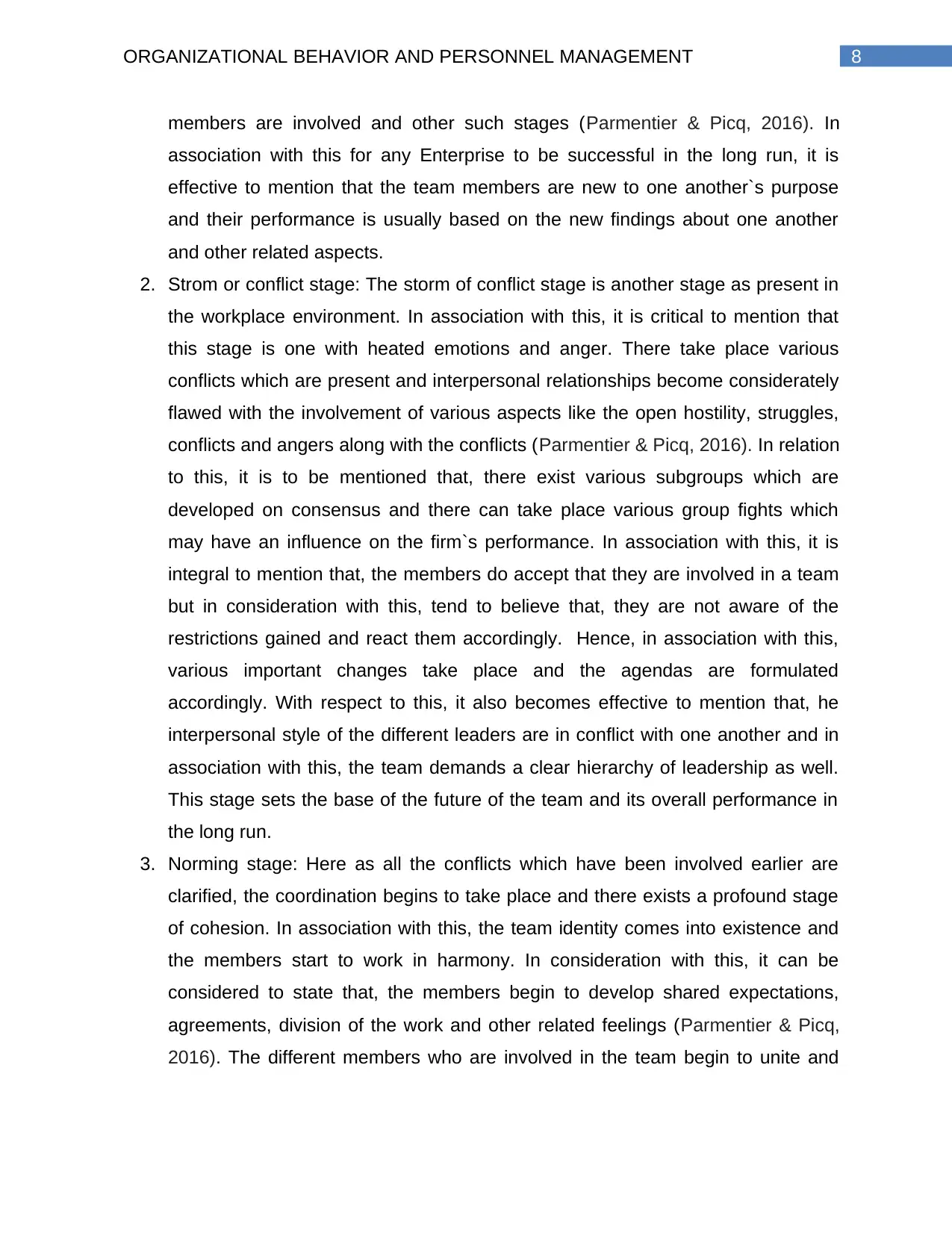
8ORGANIZATIONAL BEHAVIOR AND PERSONNEL MANAGEMENT
members are involved and other such stages (Parmentier & Picq, 2016). In
association with this for any Enterprise to be successful in the long run, it is
effective to mention that the team members are new to one another`s purpose
and their performance is usually based on the new findings about one another
and other related aspects.
2. Strom or conflict stage: The storm of conflict stage is another stage as present in
the workplace environment. In association with this, it is critical to mention that
this stage is one with heated emotions and anger. There take place various
conflicts which are present and interpersonal relationships become considerately
flawed with the involvement of various aspects like the open hostility, struggles,
conflicts and angers along with the conflicts (Parmentier & Picq, 2016). In relation
to this, it is to be mentioned that, there exist various subgroups which are
developed on consensus and there can take place various group fights which
may have an influence on the firm`s performance. In association with this, it is
integral to mention that, the members do accept that they are involved in a team
but in consideration with this, tend to believe that, they are not aware of the
restrictions gained and react them accordingly. Hence, in association with this,
various important changes take place and the agendas are formulated
accordingly. With respect to this, it also becomes effective to mention that, he
interpersonal style of the different leaders are in conflict with one another and in
association with this, the team demands a clear hierarchy of leadership as well.
This stage sets the base of the future of the team and its overall performance in
the long run.
3. Norming stage: Here as all the conflicts which have been involved earlier are
clarified, the coordination begins to take place and there exists a profound stage
of cohesion. In association with this, the team identity comes into existence and
the members start to work in harmony. In consideration with this, it can be
considered to state that, the members begin to develop shared expectations,
agreements, division of the work and other related feelings (Parmentier & Picq,
2016). The different members who are involved in the team begin to unite and
members are involved and other such stages (Parmentier & Picq, 2016). In
association with this for any Enterprise to be successful in the long run, it is
effective to mention that the team members are new to one another`s purpose
and their performance is usually based on the new findings about one another
and other related aspects.
2. Strom or conflict stage: The storm of conflict stage is another stage as present in
the workplace environment. In association with this, it is critical to mention that
this stage is one with heated emotions and anger. There take place various
conflicts which are present and interpersonal relationships become considerately
flawed with the involvement of various aspects like the open hostility, struggles,
conflicts and angers along with the conflicts (Parmentier & Picq, 2016). In relation
to this, it is to be mentioned that, there exist various subgroups which are
developed on consensus and there can take place various group fights which
may have an influence on the firm`s performance. In association with this, it is
integral to mention that, the members do accept that they are involved in a team
but in consideration with this, tend to believe that, they are not aware of the
restrictions gained and react them accordingly. Hence, in association with this,
various important changes take place and the agendas are formulated
accordingly. With respect to this, it also becomes effective to mention that, he
interpersonal style of the different leaders are in conflict with one another and in
association with this, the team demands a clear hierarchy of leadership as well.
This stage sets the base of the future of the team and its overall performance in
the long run.
3. Norming stage: Here as all the conflicts which have been involved earlier are
clarified, the coordination begins to take place and there exists a profound stage
of cohesion. In association with this, the team identity comes into existence and
the members start to work in harmony. In consideration with this, it can be
considered to state that, the members begin to develop shared expectations,
agreements, division of the work and other related feelings (Parmentier & Picq,
2016). The different members who are involved in the team begin to unite and
⊘ This is a preview!⊘
Do you want full access?
Subscribe today to unlock all pages.

Trusted by 1+ million students worldwide
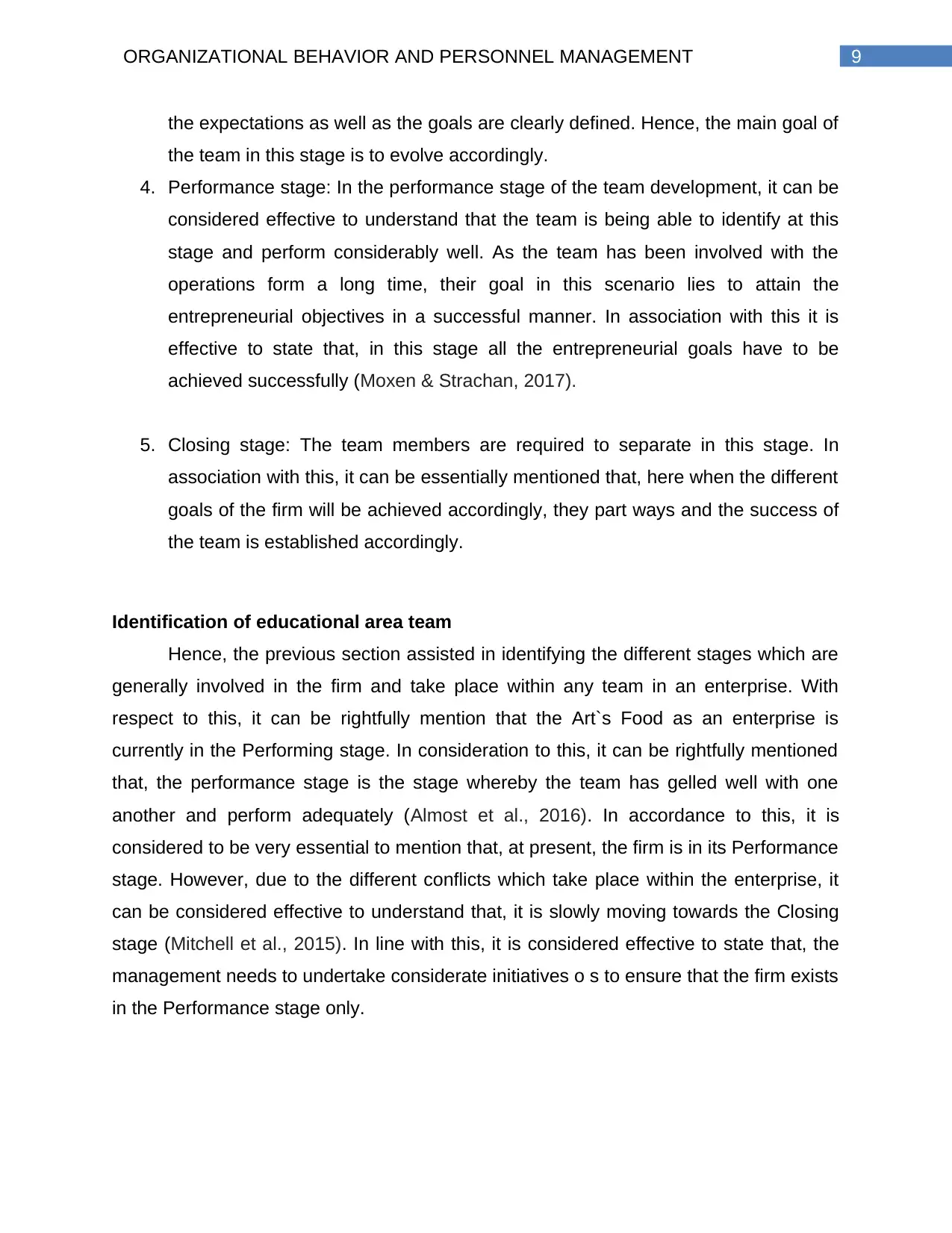
9ORGANIZATIONAL BEHAVIOR AND PERSONNEL MANAGEMENT
the expectations as well as the goals are clearly defined. Hence, the main goal of
the team in this stage is to evolve accordingly.
4. Performance stage: In the performance stage of the team development, it can be
considered effective to understand that the team is being able to identify at this
stage and perform considerably well. As the team has been involved with the
operations form a long time, their goal in this scenario lies to attain the
entrepreneurial objectives in a successful manner. In association with this it is
effective to state that, in this stage all the entrepreneurial goals have to be
achieved successfully (Moxen & Strachan, 2017).
5. Closing stage: The team members are required to separate in this stage. In
association with this, it can be essentially mentioned that, here when the different
goals of the firm will be achieved accordingly, they part ways and the success of
the team is established accordingly.
Identification of educational area team
Hence, the previous section assisted in identifying the different stages which are
generally involved in the firm and take place within any team in an enterprise. With
respect to this, it can be rightfully mention that the Art`s Food as an enterprise is
currently in the Performing stage. In consideration to this, it can be rightfully mentioned
that, the performance stage is the stage whereby the team has gelled well with one
another and perform adequately (Almost et al., 2016). In accordance to this, it is
considered to be very essential to mention that, at present, the firm is in its Performance
stage. However, due to the different conflicts which take place within the enterprise, it
can be considered effective to understand that, it is slowly moving towards the Closing
stage (Mitchell et al., 2015). In line with this, it is considered effective to state that, the
management needs to undertake considerate initiatives o s to ensure that the firm exists
in the Performance stage only.
the expectations as well as the goals are clearly defined. Hence, the main goal of
the team in this stage is to evolve accordingly.
4. Performance stage: In the performance stage of the team development, it can be
considered effective to understand that the team is being able to identify at this
stage and perform considerably well. As the team has been involved with the
operations form a long time, their goal in this scenario lies to attain the
entrepreneurial objectives in a successful manner. In association with this it is
effective to state that, in this stage all the entrepreneurial goals have to be
achieved successfully (Moxen & Strachan, 2017).
5. Closing stage: The team members are required to separate in this stage. In
association with this, it can be essentially mentioned that, here when the different
goals of the firm will be achieved accordingly, they part ways and the success of
the team is established accordingly.
Identification of educational area team
Hence, the previous section assisted in identifying the different stages which are
generally involved in the firm and take place within any team in an enterprise. With
respect to this, it can be rightfully mention that the Art`s Food as an enterprise is
currently in the Performing stage. In consideration to this, it can be rightfully mentioned
that, the performance stage is the stage whereby the team has gelled well with one
another and perform adequately (Almost et al., 2016). In accordance to this, it is
considered to be very essential to mention that, at present, the firm is in its Performance
stage. However, due to the different conflicts which take place within the enterprise, it
can be considered effective to understand that, it is slowly moving towards the Closing
stage (Mitchell et al., 2015). In line with this, it is considered effective to state that, the
management needs to undertake considerate initiatives o s to ensure that the firm exists
in the Performance stage only.
Paraphrase This Document
Need a fresh take? Get an instant paraphrase of this document with our AI Paraphraser

10ORGANIZATIONAL BEHAVIOR AND PERSONNEL MANAGEMENT
Formal and informal teams’ identification
As per the typology of the different teams, it can be agreed upon that, there are
mainly two types of teams. In association with this, it can be agreed to it that the
unplanned classification of groups can be stated to be the Formal and informal teams
The Formal work teams can be mentioned to be the teams whereby that are officially
formulated to achieve the overall goals of the enterprise. In association with this, it is
effective to mention that these groups are created to perform certain essential tasks. In
line with this, it is important to consider that the department formulates the team and
based on this they also tend to undertake decisions and maintain enterprise aspects
accordingly (Mitchell et al., 2015). In line with this, it can also be considered to be
effective that, the team leaders are assigned by them and the team is monitored
regularly in relation to the achievement of the objectives.
The team is formulated by the management and the performance is influenced
by monetary rewards. In addition to this, the leader is appointed by the organizational
heads and the interpersonal relationship are maintained by the standard of the work.
On the other hand, the Informal teams in the workplace can be defined as those
teams which generally perform tasks which is not required for the enterprise as a whole
and in association with this, carryout informal work which is essential for the firm. These
teams have a series of characteristics which are crucial to be carried out by the
enterprise and they are not formulated by the organizational heads and tend to emerge
on a spontaneous basis (Lacerenza et al., 2018). These teams are often recognized as
the teams of interests and the members come together for common causes.
In regard to this, it is essential to note that if there are certain issues which relate
to the organizational objectives tend to arise, it is effective to consider that, the natural
relationships amongst the different associates are formulated accordingly. These
groups generally have a positive influence on organizational performance and help in
meeting the different needs. In line with this, the characteristics of the informal teams
can be mentioned to be the leader is spontaneous, the interpersonal relationships are
also spontaneous, the control is limited, the origins of the group are spontaneous and
the influence on the group is rather spontaneous in nature (Ellwart et al., 2015).
Formal and informal teams’ identification
As per the typology of the different teams, it can be agreed upon that, there are
mainly two types of teams. In association with this, it can be agreed to it that the
unplanned classification of groups can be stated to be the Formal and informal teams
The Formal work teams can be mentioned to be the teams whereby that are officially
formulated to achieve the overall goals of the enterprise. In association with this, it is
effective to mention that these groups are created to perform certain essential tasks. In
line with this, it is important to consider that the department formulates the team and
based on this they also tend to undertake decisions and maintain enterprise aspects
accordingly (Mitchell et al., 2015). In line with this, it can also be considered to be
effective that, the team leaders are assigned by them and the team is monitored
regularly in relation to the achievement of the objectives.
The team is formulated by the management and the performance is influenced
by monetary rewards. In addition to this, the leader is appointed by the organizational
heads and the interpersonal relationship are maintained by the standard of the work.
On the other hand, the Informal teams in the workplace can be defined as those
teams which generally perform tasks which is not required for the enterprise as a whole
and in association with this, carryout informal work which is essential for the firm. These
teams have a series of characteristics which are crucial to be carried out by the
enterprise and they are not formulated by the organizational heads and tend to emerge
on a spontaneous basis (Lacerenza et al., 2018). These teams are often recognized as
the teams of interests and the members come together for common causes.
In regard to this, it is essential to note that if there are certain issues which relate
to the organizational objectives tend to arise, it is effective to consider that, the natural
relationships amongst the different associates are formulated accordingly. These
groups generally have a positive influence on organizational performance and help in
meeting the different needs. In line with this, the characteristics of the informal teams
can be mentioned to be the leader is spontaneous, the interpersonal relationships are
also spontaneous, the control is limited, the origins of the group are spontaneous and
the influence on the group is rather spontaneous in nature (Ellwart et al., 2015).

11ORGANIZATIONAL BEHAVIOR AND PERSONNEL MANAGEMENT
In association with this, the different groups which have been formulated can be
mentioned to be related to Formal work groups. The relationships are very cordial
amongst the different team members; however, the team has been essentially
formulated by the different transitional heads for a specific purpose of managing the
team goals and managing the Educational areas.
Meredith Belbin Typology
All individuals generally tend to display a particular type of behavior and their
overall personality differs with respect to characters, work habits and the overall
thinking. In association with this, it is effective to mention that, the different individuals
might be committed to achieve their goals but, they might act differently. The
development of roles, team members and their overall performance may also be
coordinated accordingly (DuFrene & Lehman, 2015).
The team role can be effectively defined as a tendency to behave in a certain
manner and contribute socially. In association with this, according to Doctor Meredith
Belbin the different managers are required to take into account and distinguish the roles
which they would like to assume, the bigger role which they shall assume and the role
which others expect to take and the role which is attributed and the role which is
assumed.
In a team there are various roles which are present which are Aggressive and
peaceful, authoritarian, shy, charismatic, mean and selfish , intolerant, loving and others
(Lacerenza et al., 2015).
The leader in a team can be defined as an individual who is largely involved in
ensuring that organizational goals are attained, and the team members are able to
perform adequately well. In association with this, it can be considered relevant that the
leader is being able to support entrepreneurial goals.
Coordinator: The coordinator can be described as an individual who manages
the roles of the different individuals and ensures overall success. They are
responsible for the manner in which the entire enterprise is required to function
adequately (Caldarella et al., 2015).
In association with this, the different groups which have been formulated can be
mentioned to be related to Formal work groups. The relationships are very cordial
amongst the different team members; however, the team has been essentially
formulated by the different transitional heads for a specific purpose of managing the
team goals and managing the Educational areas.
Meredith Belbin Typology
All individuals generally tend to display a particular type of behavior and their
overall personality differs with respect to characters, work habits and the overall
thinking. In association with this, it is effective to mention that, the different individuals
might be committed to achieve their goals but, they might act differently. The
development of roles, team members and their overall performance may also be
coordinated accordingly (DuFrene & Lehman, 2015).
The team role can be effectively defined as a tendency to behave in a certain
manner and contribute socially. In association with this, according to Doctor Meredith
Belbin the different managers are required to take into account and distinguish the roles
which they would like to assume, the bigger role which they shall assume and the role
which others expect to take and the role which is attributed and the role which is
assumed.
In a team there are various roles which are present which are Aggressive and
peaceful, authoritarian, shy, charismatic, mean and selfish , intolerant, loving and others
(Lacerenza et al., 2015).
The leader in a team can be defined as an individual who is largely involved in
ensuring that organizational goals are attained, and the team members are able to
perform adequately well. In association with this, it can be considered relevant that the
leader is being able to support entrepreneurial goals.
Coordinator: The coordinator can be described as an individual who manages
the roles of the different individuals and ensures overall success. They are
responsible for the manner in which the entire enterprise is required to function
adequately (Caldarella et al., 2015).
⊘ This is a preview!⊘
Do you want full access?
Subscribe today to unlock all pages.

Trusted by 1+ million students worldwide
1 out of 32
Related Documents
Your All-in-One AI-Powered Toolkit for Academic Success.
+13062052269
info@desklib.com
Available 24*7 on WhatsApp / Email
![[object Object]](/_next/static/media/star-bottom.7253800d.svg)
Unlock your academic potential
Copyright © 2020–2025 A2Z Services. All Rights Reserved. Developed and managed by ZUCOL.





